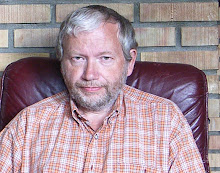A picture of the cups on a plate at the end of the experiment (do try this at home!), see Part 1.
So why did the ice cube in the cup labelled FARRIS+ melt slower? Well, CO2 dissolved in water and lemon drops both have acid characteristics that perhaps work together. Much like CO2 and sulfer plus moisture in the atmosphere, I guess. Streams of hotter fluids have a tendency to keep the heat they get from surroundings away from other streams that are cooler, if there is no forced convection at work.
The liquids in the cups was not stirred, so warm currents of almost same temperature would easily segregate the most heat effective collecting parts of liquids and follow each other around in the cups. The most effective streams to collect heat would contain both CO2 and lemon traces, and not only CO2. These more narrow streams would isolate the heat from the bigger colder streams of much less CO2 (and less lemon traces), so there would easily be colder streams to dominate the outside of the ice cube in both the cups labelled FARRIS and FARRIS+. That's why the ice cube in the cup containing only water melted faster and more even than the ice cube in the other cups: And the more ablong chip of ice in the other cups confirm a more differentiated environment with greater temperature differences between the currents.
So, yes, more CO2 and aerosols (especially containing acid parts) in the environment must be to blame for increased temperature differences (and more unstable weather) that we suffer under all over the world. The less mixture of fluids (especially in more calm weather conditions) means that heat are trapped more easily in air and water, so energies are delayed from radiating to space and only leave Earth in bigger, later chunks of energy. That gives the impression that the world is heating up in some periods and some places, and cooling down in other periods and other places. But as long as the level of CO2 and acid forming aerosols are high and still higher, the global temperature will rise totally - though there will be more often snow in The Middle East (but more melting of ice in The Arctic area). IT'S REAL, FOLKS !!!!
I will tomorrow complete my experiment by having taped suction straws through the lids to find out if stirring the content of cups every two minutes cause a smaller difference to the melting of the ice cubes. Perhaps you will try that out for yourselves, too?
Subscribe to:
Post Comments (Atom)



No comments:
Post a Comment